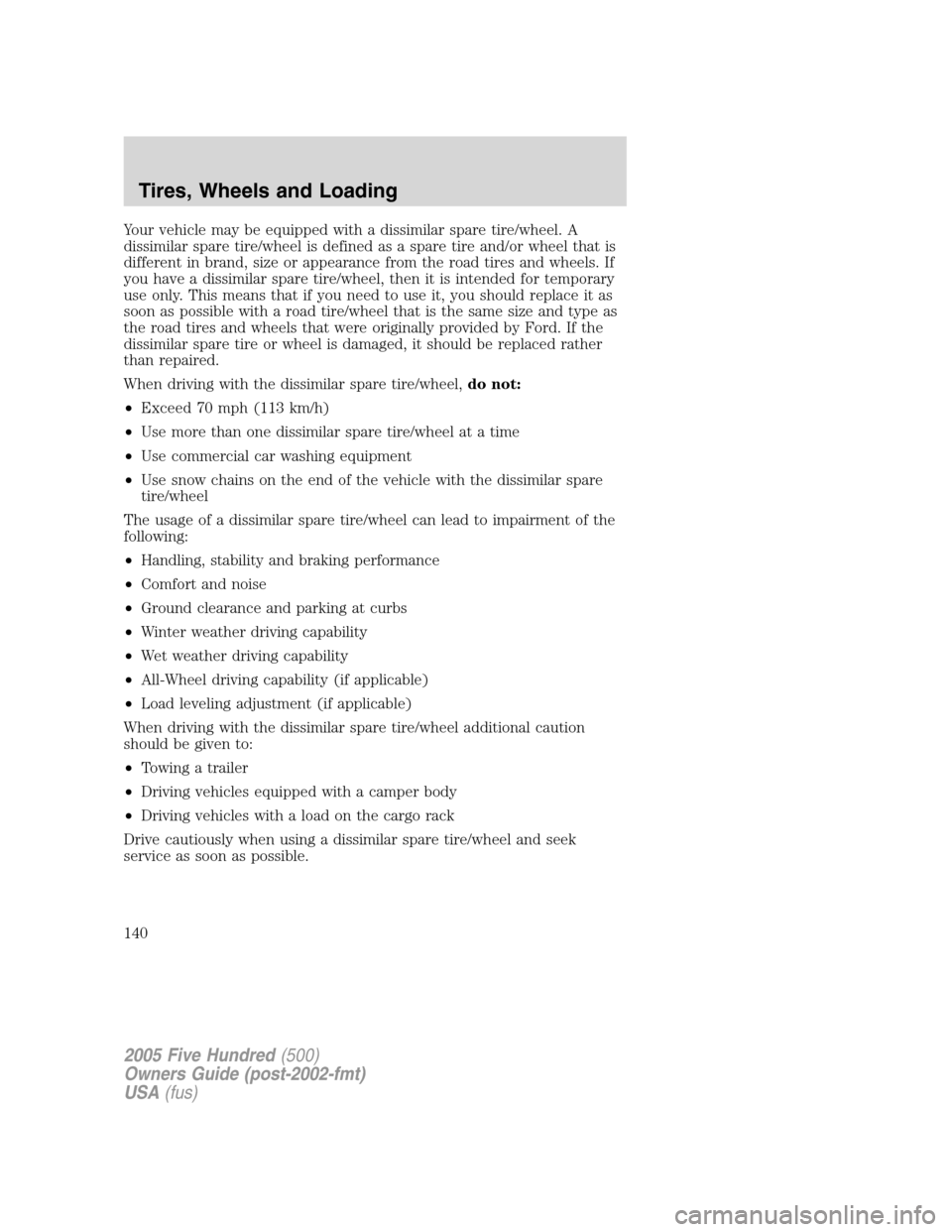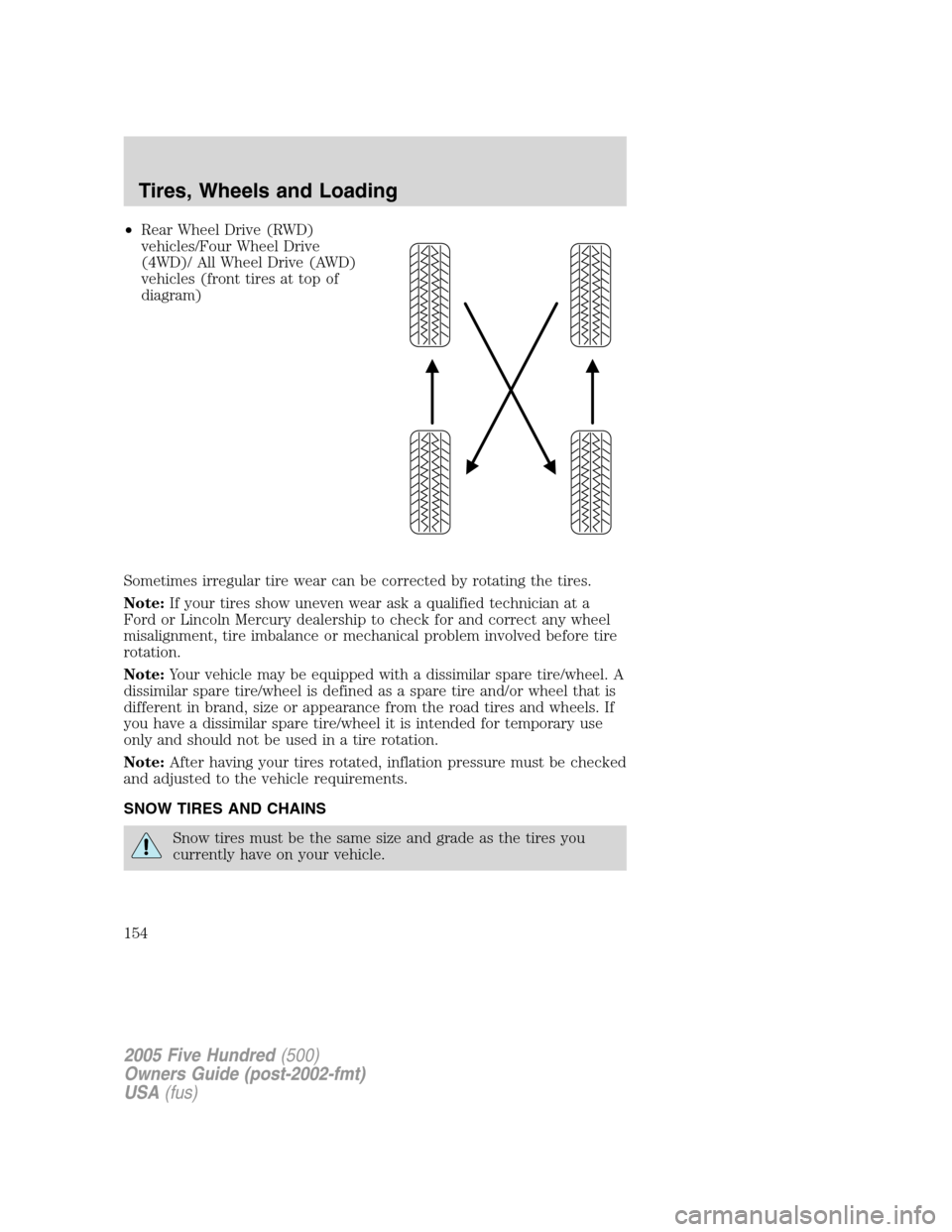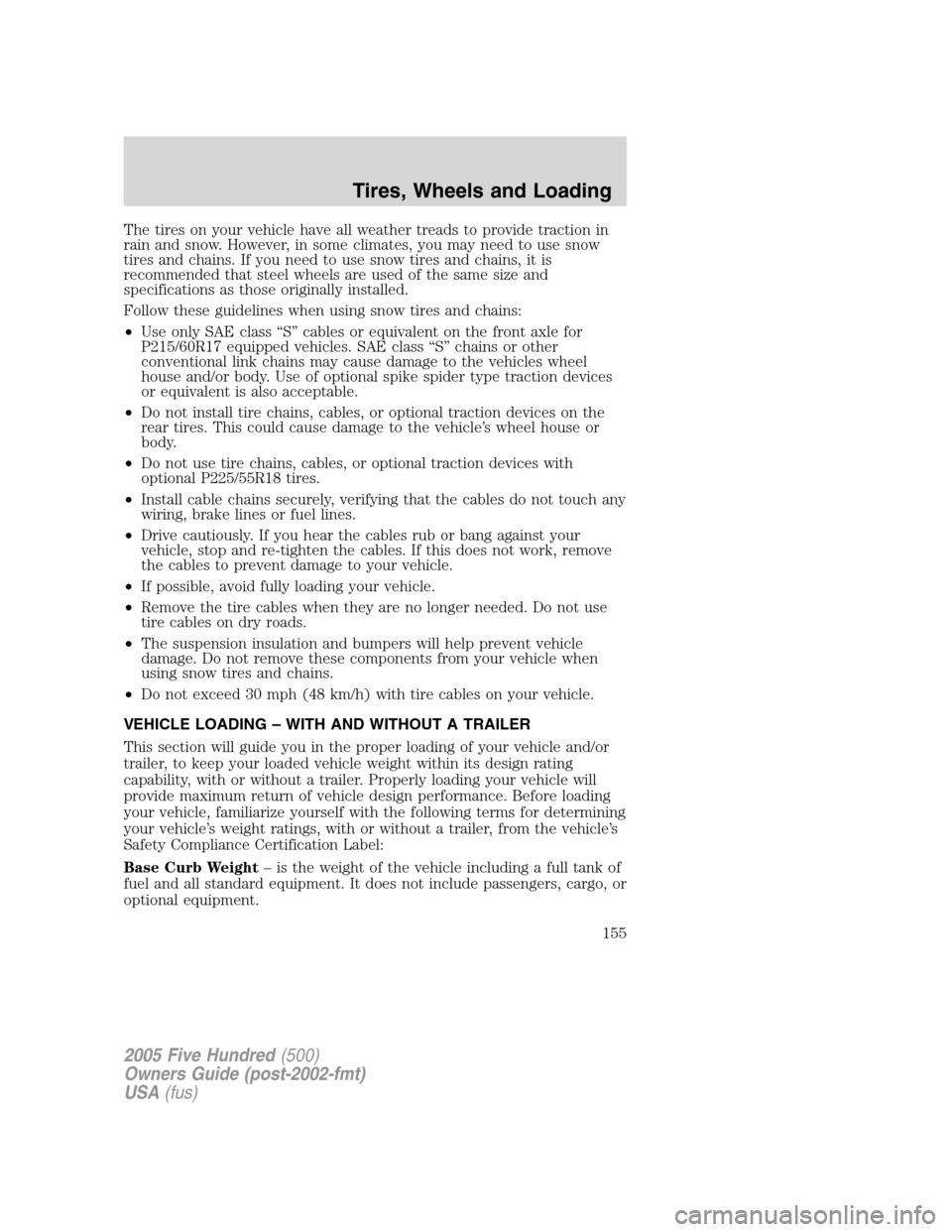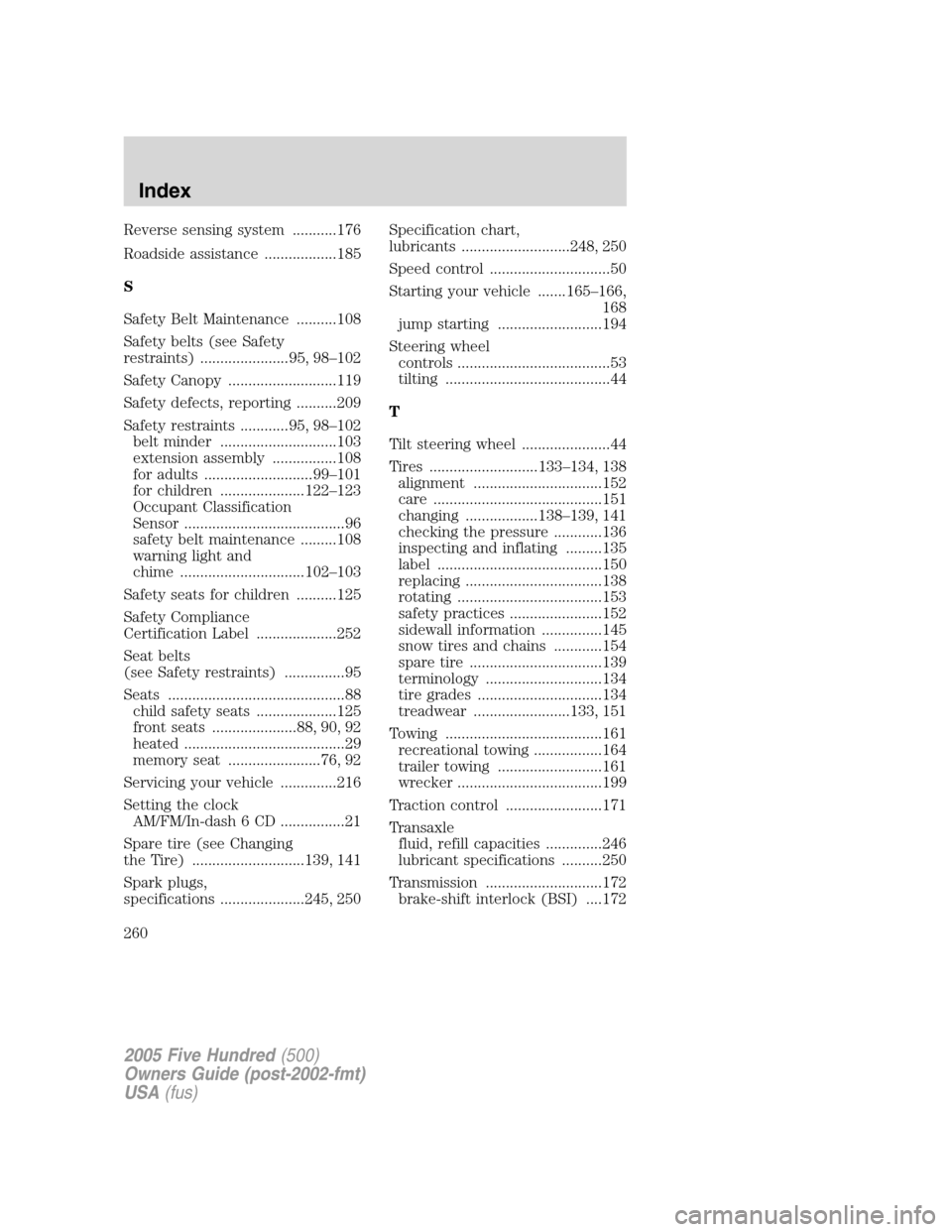snow chains FORD FIVE HUNDRED 2005 D258 / 1.G Owners Manual
[x] Cancel search | Manufacturer: FORD, Model Year: 2005, Model line: FIVE HUNDRED, Model: FORD FIVE HUNDRED 2005 D258 / 1.GPages: 264, PDF Size: 2.26 MB
Page 140 of 264

Your vehicle may be equipped with a dissimilar spare tire/wheel. A
dissimilar spare tire/wheel is defined as a spare tire and/or wheel that is
different in brand, size or appearance from the road tires and wheels. If
you have a dissimilar spare tire/wheel, then it is intended for temporary
use only. This means that if you need to use it, you should replace it as
soon as possible with a road tire/wheel that is the same size and type as
the road tires and wheels that were originally provided by Ford. If the
dissimilar spare tire or wheel is damaged, it should be replaced rather
than repaired.
When driving with the dissimilar spare tire/wheel,do not:
•Exceed 70 mph (113 km/h)
•Use more than one dissimilar spare tire/wheel at a time
•Use commercial car washing equipment
•Use snow chains on the end of the vehicle with the dissimilar spare
tire/wheel
The usage of a dissimilar spare tire/wheel can lead to impairment of the
following:
•Handling, stability and braking performance
•Comfort and noise
•Ground clearance and parking at curbs
•Winter weather driving capability
•Wet weather driving capability
•All-Wheel driving capability (if applicable)
•Load leveling adjustment (if applicable)
When driving with the dissimilar spare tire/wheel additional caution
should be given to:
•Towing a trailer
•Driving vehicles equipped with a camper body
•Driving vehicles with a load on the cargo rack
Drive cautiously when using a dissimilar spare tire/wheel and seek
service as soon as possible.
2005 Five Hundred(500)
Owners Guide (post-2002-fmt)
USA(fus)
Tires, Wheels and Loading
140
Page 154 of 264

•Rear Wheel Drive (RWD)
vehicles/Four Wheel Drive
(4WD)/ All Wheel Drive (AWD)
vehicles (front tires at top of
diagram)
Sometimes irregular tire wear can be corrected by rotating the tires.
Note:If your tires show uneven wear ask a qualified technician at a
Ford or Lincoln Mercury dealership to check for and correct any wheel
misalignment, tire imbalance or mechanical problem involved before tire
rotation.
Note:Your vehicle may be equipped with a dissimilar spare tire/wheel. A
dissimilar spare tire/wheel is defined as a spare tire and/or wheel that is
different in brand, size or appearance from the road tires and wheels. If
you have a dissimilar spare tire/wheel it is intended for temporary use
only and should not be used in a tire rotation.
Note:After having your tires rotated, inflation pressure must be checked
and adjusted to the vehicle requirements.
SNOW TIRES AND CHAINS
Snow tires must be the same size and grade as the tires you
currently have on your vehicle.
2005 Five Hundred(500)
Owners Guide (post-2002-fmt)
USA(fus)
Tires, Wheels and Loading
154
Page 155 of 264

The tires on your vehicle have all weather treads to provide traction in
rain and snow. However, in some climates, you may need to use snow
tires and chains. If you need to use snow tires and chains, it is
recommended that steel wheels are used of the same size and
specifications as those originally installed.
Follow these guidelines when using snow tires and chains:
•Use only SAE class “S” cables or equivalent on the front axle for
P215/60R17 equipped vehicles. SAE class “S” chains or other
conventional link chains may cause damage to the vehicles wheel
house and/or body. Use of optional spike spider type traction devices
or equivalent is also acceptable.
•Do not install tire chains, cables, or optional traction devices on the
rear tires. This could cause damage to the vehicle’s wheel house or
body.
•Do not use tire chains, cables, or optional traction devices with
optional P225/55R18 tires.
•Install cable chains securely, verifying that the cables do not touch any
wiring, brake lines or fuel lines.
•Drive cautiously. If you hear the cables rub or bang against your
vehicle, stop and re-tighten the cables. If this does not work, remove
the cables to prevent damage to your vehicle.
•If possible, avoid fully loading your vehicle.
•Remove the tire cables when they are no longer needed. Do not use
tire cables on dry roads.
•The suspension insulation and bumpers will help prevent vehicle
damage. Do not remove these components from your vehicle when
using snow tires and chains.
•Do not exceed 30 mph (48 km/h) with tire cables on your vehicle.
VEHICLE LOADING – WITH AND WITHOUT A TRAILER
This section will guide you in the proper loading of your vehicle and/or
trailer, to keep your loaded vehicle weight within its design rating
capability, with or without a trailer. Properly loading your vehicle will
provide maximum return of vehicle design performance. Before loading
your vehicle, familiarize yourself with the following terms for determining
your vehicle’s weight ratings, with or without a trailer, from the vehicle’s
Safety Compliance Certification Label:
Base Curb Weight– is the weight of the vehicle including a full tank of
fuel and all standard equipment. It does not include passengers, cargo, or
optional equipment.
2005 Five Hundred(500)
Owners Guide (post-2002-fmt)
USA(fus)
Tires, Wheels and Loading
155
Page 260 of 264

Reverse sensing system ...........176
Roadside assistance ..................185
S
Safety Belt Maintenance ..........108
Safety belts (see Safety
restraints) ......................95, 98–102
Safety Canopy ...........................119
Safety defects, reporting ..........209
Safety restraints ............95, 98–102
belt minder .............................103
extension assembly ................108
for adults ...........................99–101
for children .....................122–123
Occupant Classification
Sensor ........................................96
safety belt maintenance .........108
warning light and
chime ...............................102–103
Safety seats for children ..........125
Safety Compliance
Certification Label ....................252
Seat belts
(see Safety restraints) ...............95
Seats ............................................88
child safety seats ....................125
front seats .....................88, 90, 92
heated ........................................29
memory seat .......................76, 92
Servicing your vehicle ..............216
Setting the clock
AM/FM/In-dash 6 CD ................21
Spare tire (see Changing
the Tire) ............................139, 141
Spark plugs,
specifications .....................245, 250Specification chart,
lubricants ...........................248, 250
Speed control ..............................50
Starting your vehicle .......165–166,
168
jump starting ..........................194
Steering wheel
controls ......................................53
tilting .........................................44
T
Tilt steering wheel ......................44
Tires ...........................133–134, 138
alignment ................................152
care ..........................................151
changing ..................138–139, 141
checking the pressure ............136
inspecting and inflating .........135
label .........................................150
replacing ..................................138
rotating ....................................153
safety practices .......................152
sidewall information ...............145
snow tires and chains ............154
spare tire .................................139
terminology .............................134
tire grades ...............................134
treadwear ........................133, 151
Towing .......................................161
recreational towing .................164
trailer towing ..........................161
wrecker ....................................199
Traction control ........................171
Transaxle
fluid, refill capacities ..............246
lubricant specifications ..........250
Transmission .............................172
brake-shift interlock (BSI) ....172
2005 Five Hundred(500)
Owners Guide (post-2002-fmt)
USA(fus)
Index
260